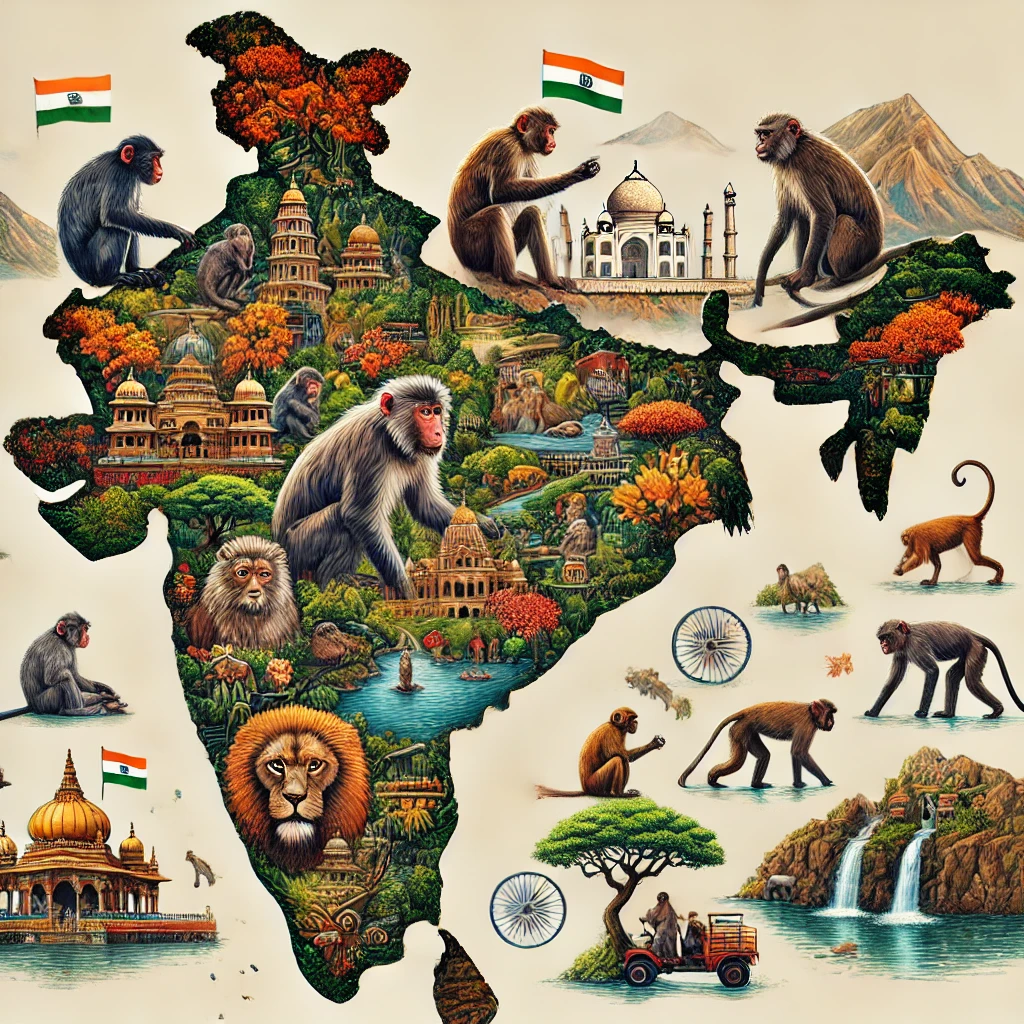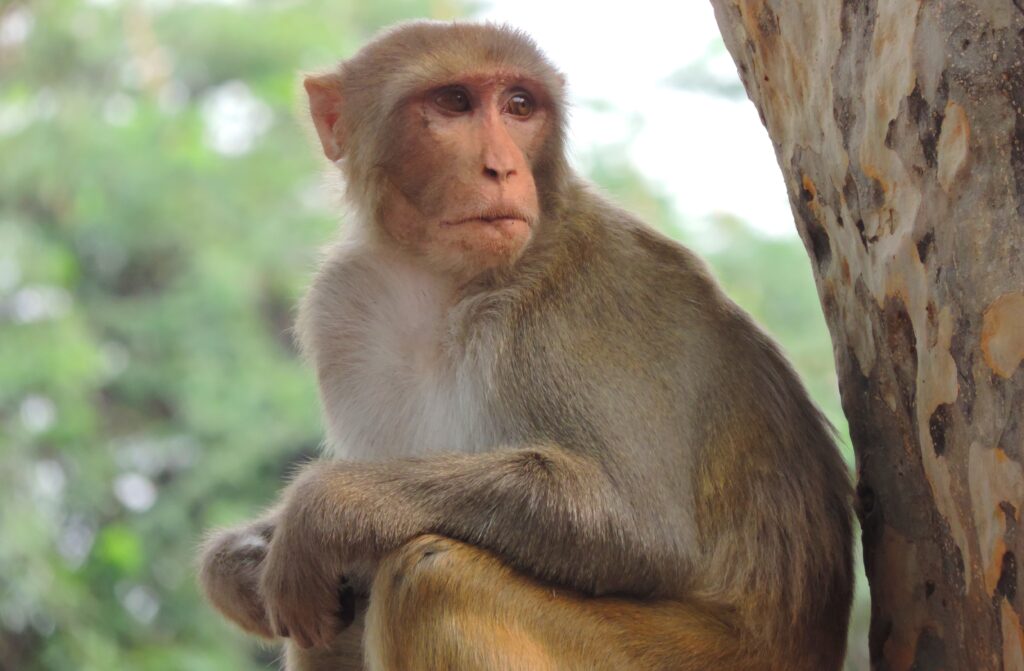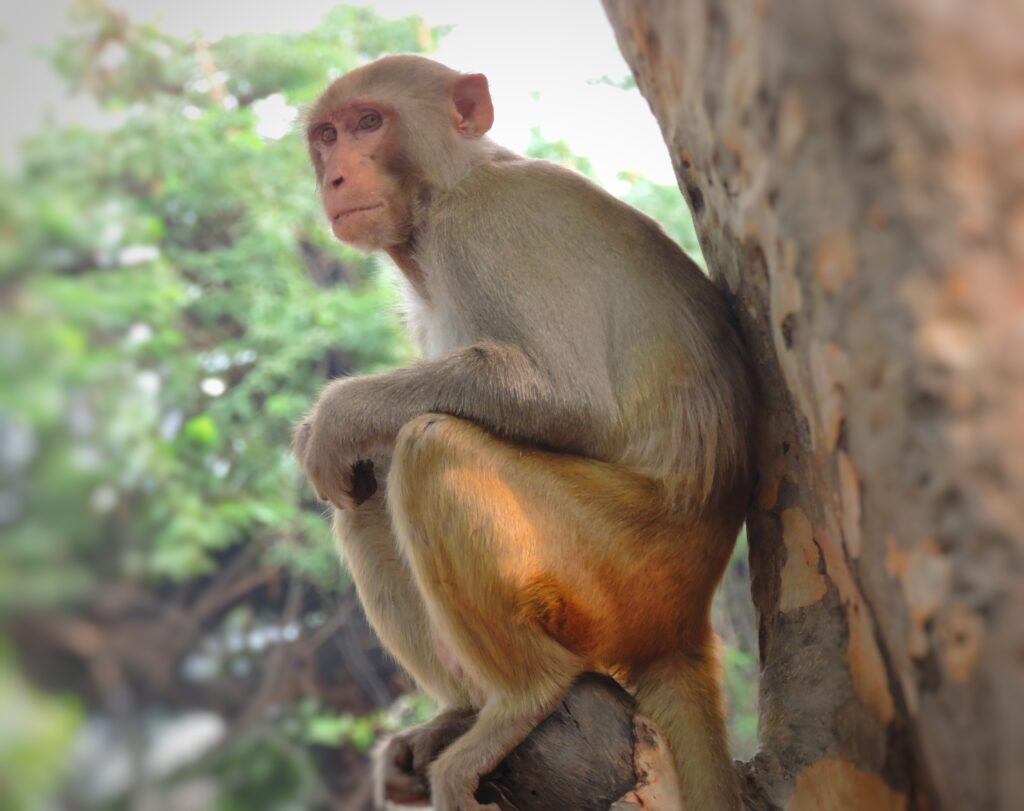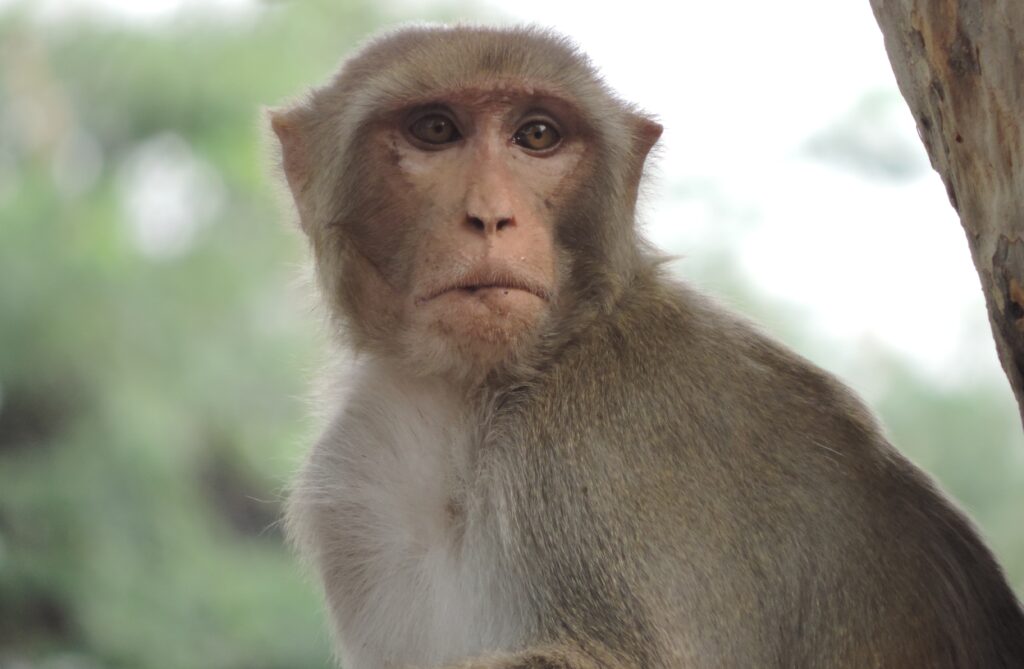This stunning photograph was taken during a leisurely walk through the vibrant streets of Delhi. As I strolled, I came across this fascinating monkey perched thoughtfully by a tree, exuding both intelligence and serenity. Its intense gaze and calm posture immediately caught my attention. The earthy tones of its fur perfectly complement the lush green background, creating a harmonious contrast. This moment highlights the rich biodiversity thriving even in India’s bustling urban spaces.
Wildlife photography is all about seizing such fleeting moments, and this image is a testament to the art of observation and timing. Monkeys are highly intelligent creatures, and their expressive behavior makes them intriguing subjects for photographers. This photo, captured with precision and love for nature, is a tribute to the delicate balance between wildlife and urbanization.

Monkey Populations in India
India is home to an incredible variety of wildlife, and monkeys are among the most common mammals found across the country. There are several species of monkeys in India, with two of the most prominent being:
1. Rhesus Macaque: These monkeys are highly adaptable and can be seen in forests, rural areas, and even cities like Delhi.
2. Hanuman Langur: Named after Lord Hanuman, they are revered for their connection to Indian mythology and can often be found near temples and religious sites.
The population of monkeys in India is estimated to be in the millions, making them an essential part of the country’s biodiversity. Their presence is vital for maintaining ecological balance. For example, monkeys play a crucial role in seed dispersal, contributing to forest regeneration.
Why Monkeys Are Special to Indians
Monkeys hold a unique place in Indian culture, especially within the context of Hinduism. They are associated with Lord Hanuman, a deity known for his strength, devotion, and loyalty. According to the epic Ramayana, Hanuman played a pivotal role in helping Lord Rama rescue Sita from Ravana.
1. Religious Significance
Monkeys are often seen as earthly manifestations of Lord Hanuman, and they are treated with reverence in temples and religious sites across India. During festivals like Hanuman Jayanti, monkeys are fed fruits, sweets, and other offerings as a gesture of devotion.
2. Symbol of Strength and Devotion
Hanuman is considered a symbol of unwavering strength and devotion. Monkeys, by extension, are seen as spiritual creatures that embody these qualities. This connection fosters a sense of respect and protection towards them among many Indians.
3. Folklore and Stories
Monkeys feature prominently in Indian folklore and children’s tales. These stories often portray them as clever and mischievous beings, adding to their cultural significance.
Challenges Monkeys Face in India
Despite their revered status, monkeys in India face numerous challenges due to increasing urbanization and habitat loss. Deforestation forces them to venture into cities and towns in search of food, leading to conflicts with humans. In places like Delhi, monkeys are often seen scavenging through garbage or raiding markets, which can create tension between humans and wildlife.
1. Human-Wildlife Conflict
Monkeys entering urban areas often clash with humans. They are known to snatch food, damage property, and, in some cases, even attack people.
2. Habitat Loss
Rapid deforestation and urban expansion have significantly reduced the natural habitats of monkeys, making it difficult for them to survive in the wild.
3. Conservation Efforts
The Indian government and wildlife organizations are working to address these issues through initiatives like:
Sterilization Programs: To control the monkey population in urban areas.
Public Awareness Campaigns: Educating people about the importance of coexistence.
Protected Areas: Establishing wildlife sanctuaries to provide a safe habitat for monkeys and other animals.

Fascinating Behaviors of Monkeys
Monkeys are highly social and intelligent animals, making them fascinating subjects for observation and study. Here are some interesting behaviors:
1. Tool Use: Monkeys have been observed using sticks, stones, and leaves to assist in tasks like foraging.
2. Complex Communication: They communicate using a variety of vocalizations, facial expressions, and body language.
3. Playful Nature: Young monkeys are incredibly playful, often seen jumping, chasing, and interacting with their peers.
4. Adaptability: In urban areas, monkeys have adapted remarkably well, learning to navigate roads, open containers, and even interact with humans.

Wildlife Photography Tips
Capturing a photograph like this one requires a mix of patience, skill, and understanding of animal behavior. Here are some tips for photographing wildlife:
1. Choose the Right Equipment: A DSLR or mirrorless camera with a zoom lens is ideal for capturing details from a distance.
2. Observe and Wait: Spend time observing the animal’s behavior to predict its movements and capture natural moments.
3. Focus on the Eyes: In wildlife photography, the subject’s eyes can convey emotion and create a connection with the viewer.
4. Use Natural Light: Morning and evening light is ideal for wildlife photography, as it adds warmth and depth to the images.
5. Respect the Subject: Avoid disturbing the animal or its environment. Ethical photography is essential to protect wildlife.
Monkeys and Indian Tourism
Monkeys are a significant attraction for tourists visiting India. Temples like:
1. Galta Monkey Temple (Jaipur): Famous for its large monkey population.
2. Hanuman Temple (Hampi): Known for its historical and spiritual significance.
3. Varanasi Ghats: Monkeys are often seen along the ghats, adding to the charm of this ancient city.
These sites draw visitors who are fascinated by the close interactions between humans and monkeys, as well as the cultural stories surrounding them.
Conclusion
This photograph of a monkey in Delhi captures more than just a moment; it tells a story of coexistence, culture, and conservation. Monkeys are not only an integral part of India’s biodiversity but also deeply embedded in its cultural and religious fabric. By understanding their significance and addressing the challenges they face, we can foster a harmonious relationship with these remarkable creatures.



